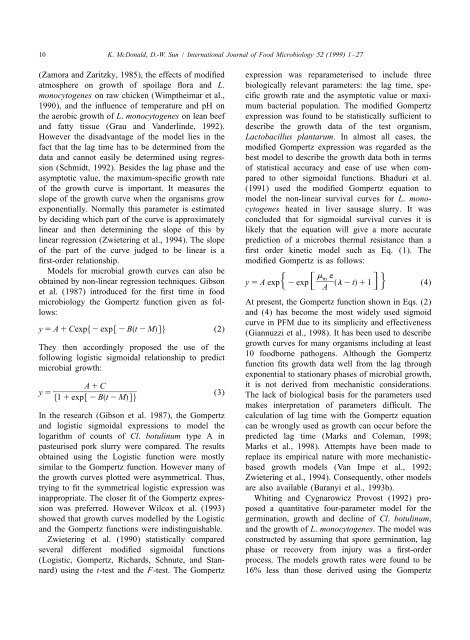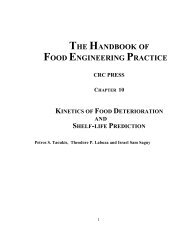Predictive food microbiology for the meat industry: a review
Predictive food microbiology for the meat industry: a review
Predictive food microbiology for the meat industry: a review
Create successful ePaper yourself
Turn your PDF publications into a flip-book with our unique Google optimized e-Paper software.
10 K. McDonald, D.-W. Sun / International Journal of Food Microbiology 52 (1999) 1 –27<br />
(Zamora and Zaritzky, 1985), <strong>the</strong> effects of modified expression was reparameterised to include three<br />
atmosphere on growth of spoilage flora and L. biologically relevant parameters: <strong>the</strong> lag time, spemonocytogenes<br />
on raw chicken (Wimp<strong>the</strong>imar et al., cific growth rate and <strong>the</strong> asymptotic value or maxi-<br />
1990), and <strong>the</strong> influence of temperature and pH on mum bacterial population. The modified Gompertz<br />
<strong>the</strong> aerobic growth of L. monocytogenes on lean beef expression was found to be statistically sufficient to<br />
and fatty tissue (Grau and Vanderlinde, 1992). describe <strong>the</strong> growth data of <strong>the</strong> test organism,<br />
However <strong>the</strong> disadvantage of <strong>the</strong> model lies in <strong>the</strong> Lactobacillus plantarum. In almost all cases, <strong>the</strong><br />
fact that <strong>the</strong> lag time has to be determined from <strong>the</strong> modified Gompertz expression was regarded as <strong>the</strong><br />
data and cannot easily be determined using regres- best model to describe <strong>the</strong> growth data both in terms<br />
sion (Schmidt, 1992). Besides <strong>the</strong> lag phase and <strong>the</strong> of statistical accuracy and ease of use when comasymptotic<br />
value, <strong>the</strong> maximum-specific growth rate pared to o<strong>the</strong>r sigmoidal functions. Bhaduri et al.<br />
of <strong>the</strong> growth curve is important. It measures <strong>the</strong> (1991) used <strong>the</strong> modified Gompertz equation to<br />
slope of <strong>the</strong> growth curve when <strong>the</strong> organisms grow model <strong>the</strong> non-linear survival curves <strong>for</strong> L. monoexponentially.<br />
Normally this parameter is estimated cytogenes heated in liver sausage slurry. It was<br />
by deciding which part of <strong>the</strong> curve is approximately concluded that <strong>for</strong> sigmoidal survival curves it is<br />
linear and <strong>the</strong>n determining <strong>the</strong> slope of this by likely that <strong>the</strong> equation will give a more accurate<br />
linear regression (Zwietering et al., 1994). The slope prediction of a microbes <strong>the</strong>rmal resistance than a<br />
of <strong>the</strong> part of <strong>the</strong> curve judged to be linear is a first order kinetic model such as Eq. (1). The<br />
first-order relationship.<br />
modified Gompertz is as follows:<br />
Models <strong>for</strong> microbial growth curves can also be<br />
mm<br />
e<br />
obtained by non-linear regression techniques. Gibson y 5 A expH2 expF]] l 2 t 1 1 GJ<br />
A<br />
s d<br />
et al. (1987) introduced <strong>for</strong> <strong>the</strong> first time in <strong>food</strong><br />
(4)<br />
<strong>microbiology</strong> <strong>the</strong> Gompertz function given as fol- At present, <strong>the</strong> Gompertz function shown in Eqs. (2)<br />
lows:<br />
and (4) has become <strong>the</strong> most widely used sigmoid<br />
y 5 A 1 Cexph2 expf2 Bt2 s M dgj (2)<br />
curve in PFM due to its simplicity and effectiveness<br />
(Giannuzzi et al., 1998). It has been used to describe<br />
They <strong>the</strong>n accordingly proposed <strong>the</strong> use of <strong>the</strong><br />
growth curves <strong>for</strong> many organisms including at least<br />
following logistic sigmoidal relationship to predict<br />
10 <strong>food</strong>borne pathogens. Although <strong>the</strong> Gompertz<br />
microbial growth:<br />
function fits growth data well from <strong>the</strong> lag through<br />
exponential to stationary phases of microbial growth,<br />
A 1 C<br />
it is not derived from mechanistic considerations.<br />
y 5 ]]]]]]]<br />
(3)<br />
h1 1 expf2 Bt2 s Mdgj<br />
The lack of biological basis <strong>for</strong> <strong>the</strong> parameters used<br />
makes interpretation of parameters difficult. The<br />
In <strong>the</strong> research (Gibson et al. 1987), <strong>the</strong> Gompertz calculation of lag time with <strong>the</strong> Gompertz equation<br />
and logistic sigmoidal expressions to model <strong>the</strong> can be wrongly used as growth can occur be<strong>for</strong>e <strong>the</strong><br />
logarithm of counts of Cl. botulinum type A in predicted lag time (Marks and Coleman, 1998;<br />
pasteurised pork slurry were compared. The results Marks et al., 1998). Attempts have been made to<br />
obtained using <strong>the</strong> Logistic function were mostly replace its empirical nature with more mechanisticsimilar<br />
to <strong>the</strong> Gompertz function. However many of based growth models (Van Impe et al., 1992;<br />
<strong>the</strong> growth curves plotted were asymmetrical. Thus, Zwietering et al., 1994). Consequently, o<strong>the</strong>r models<br />
trying to fit <strong>the</strong> symmetrical logistic expression was are also available (Baranyi et al., 1993b).<br />
inappropriate. The closer fit of <strong>the</strong> Gompertz expres- Whiting and Cygnarowicz Provost (1992) prosion<br />
was preferred. However Wilcox et al. (1993) posed a quantitative four-parameter model <strong>for</strong> <strong>the</strong><br />
showed that growth curves modelled by <strong>the</strong> Logistic germination, growth and decline of Cl. botulinum,<br />
and <strong>the</strong> Gompertz functions were indistinguishable. and <strong>the</strong> growth of L. monocytogenes. The model was<br />
Zwietering et al. (1990) statistically compared constructed by assuming that spore germination, lag<br />
several different modified sigmoidal functions phase or recovery from injury was a first-order<br />
(Logistic, Gompertz, Richards, Schnute, and Stan- process. The models growth rates were found to be<br />
nard) using <strong>the</strong> t-test and <strong>the</strong> F-test. The Gompertz 16% less than those derived using <strong>the</strong> Gompertz














